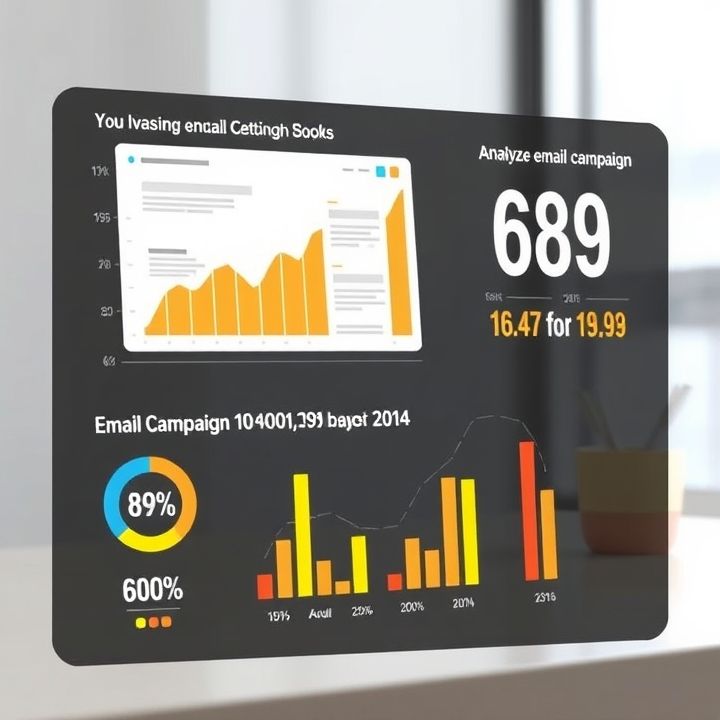Table of Contents
- Introduction
- Understand the legal requirements of GDPR and CAN-SPAM
- Obtain explicit consent from recipients
- Provide clear and easy-to-find unsubscribe options
- Include accurate sender information
- Avoid deceptive subject lines and content
- Implement data protection measures
- Regularly review and update compliance practices
- Maintain comprehensive records of consent and communications
- Conclusion
- Frequently Asked Questions
Introduction
In today’s digital age, emails are the backbone of communication, both personally and professionally. But did you know that your emailing habits could land you in hot water if not handled correctly? Enter GDPR and CAN-SPAM, the twin pillars of email compliance. Unlock the secrets to keeping your emails squeaky clean and legally compliant by diving into our comprehensive guide!
Imagine crafting that perfect email campaign, only for it to be flagged or worse, incur hefty fines. Don’t let that be your reality. Our guide is meticulously crafted to walk you through the dos and don’ts, ensuring your emails not only hit the mark but do so within the boundaries of the law.
Here’s a sneak peek:
| GDPR Compliance Tips | CAN-SPAM Compliance Tips |
|---|---|
| Explicit Consent | Unsubscribe Mechanism |
| Data Protection | Accurate Sender Info |
| Transparent Policies | Full Disclosure |
Continue reading to become a master at crafting compliant emails that not only reach your audience but also build trust and credibility.
Understand the legal requirements of GDPR and CAN-SPAM
To ensure your emails comply with legal regulations such as GDPR and CAN-SPAM, it is essential to understand their core requirements. The General Data Protection Regulation (GDPR) focuses on protecting the personal data and privacy of EU citizens. It requires explicit consent from recipients before sending marketing emails, ensures data subjects can easily withdraw consent, and mandates clear privacy notices explaining how data will be used. Compliance with GDPR also requires maintaining records of consent and implementing measures to protect personal data.
The CAN-SPAM Act, relevant primarily to the United States, sets rules for commercial emails, establishes requirements for commercial messages, and gives recipients the right to stop receiving emails. It mandates that emails should not use false or misleading header information, should avoid deceptive subject lines, and requires that commercial emails be identified as advertisements. Additionally, it requires the inclusion of the sender’s valid physical postal address and a clear, easy-to-use opt-out mechanism. Both regulations are designed to protect the rights of email recipients and promote responsible email marketing practices.
Obtain explicit consent from recipients
One of the fundamental steps in ensuring your emails comply with legal regulations such as GDPR or CAN-SPAM is to obtain explicit consent from recipients. This involves clearly informing individuals about what they are signing up for and requesting their permission before sending any marketing or promotional emails. Explicit consent can be collected through various methods such as sign-up forms on your website, checkboxes during the registration process, or even at the point of sale. It is critical that these consent requests are clear, concise, and unambiguous, leaving no room for confusion.
Maintaining records of this consent is equally important, as it provides proof that the recipient agreed to receive emails from you. Always include an easy-to-find option for recipients to withdraw their consent or unsubscribe from your mailing list. Not only does this help in maintaining compliance with regulations, but it also builds trust and credibility with your audience. By prioritizing explicit consent, you ensure that your email marketing efforts are both legally compliant and respectful of your recipients’ preferences.
Provide clear and easy-to-find unsubscribe options
One critical step to ensure your emails comply with legal regulations like GDPR and CAN-SPAM is to provide clear and easy-to-find unsubscribe options. Users should never have to hunt for a way to opt out of your communications. By placing a visible unsubscribe link in every email, usually in the footer, you demonstrate respect for the recipient’s preferences and adhere to legal requirements. Moreover, the process should be simple and straightforward; a single click should be adequate to remove them from your mailing list without unnecessary steps or delays.
Ensuring that the unsubscribe process is streamlined not only keeps you compliant but also maintains a positive relationship with your audience. A complex or hidden opt-out procedure can lead to frustration and damage your brand’s reputation. Regularly testing your unsubscribe mechanism is also a good practice. This ensures it is working correctly and that your subscribers don’t experience any technical issues.
By making the unsubscribe option prominent and user-friendly, you respect the choices of your email recipients and comply with critical legal standards, thus fostering trust and transparency in your communication strategies.
Include accurate sender information
Ensuring your emails comply with legal regulations, such as GDPR or CAN-SPAM, requires that you include accurate sender information. This is a critical step in maintaining transparency and trust with your recipients. Accurate sender information includes providing a valid email address, the sender’s name, and the physical postal address of your organization. This information should be easily visible in every email you send. According to the CAN-SPAM Act, you must not use false or misleading header information. This means the ‘From’, ‘To’, ‘Reply-To’ fields, along with the originating domain name and email address, should accurately identify the person or business that initiated the message. Similarly, under GDPR, providing transparent sender information is part of respecting the recipient’s data privacy and rights. Using generic or misleading sender information can result in penalties and damage your reputation. By including accurate sender information, you not only stay compliant with legal standards but also build credibility and foster trust with your audience.
Avoid deceptive subject lines and content
Avoiding deceptive subject lines and content is crucial in ensuring your emails comply with legal regulations like GDPR and CAN-SPAM. The subject line should accurately reflect the content of the email. Misleading subject lines can not only lead to user distrust but also violate these regulations, resulting in legal consequences.
It’s important to ensure the content of your email is truthful and not misleading. Clearly disclose any offers, promotions, or calls to action. Using deceptive tactics such as false promises or hidden terms and conditions can lead to penalties.
Make sure to include a physical address and a clear way for recipients to unsubscribe from future emails. This transparency builds trust and helps keep your email practices compliant. By prioritizing honesty and clarity in subject lines and email content, you not only adhere to legal standards but also foster a positive relationship with your audience.
Implement data protection measures
Implementing data protection measures is crucial to ensure your emails comply with legal regulations such as GDPR and CAN-SPAM. Firstly, obtain explicit consent from individuals before sending them emails. This means they should knowingly agree to receive your emails, typically through an opt-in form. Secondly, always provide a clear and easy way for recipients to unsubscribe from your emails. This helps maintain compliance and also improves your engagement rates.
Next, make sure to regularly update and secure your email list. Remove any outdated or inactive email addresses and protect your list from unauthorized access using encryption and secure storage solutions. Additionally, be transparent about how you collect, store, and use personal data. This can be done through a comprehensive privacy policy shared with your subscribers.
Finally, conduct regular audits to ensure all your email marketing practices are compliant with the latest regulations. Keep yourself updated with any changes to legal requirements and adjust your strategies accordingly. By following these steps, you not only stay compliant but also build trust with your audience, which is invaluable in the long run.
Regularly review and update compliance practices
Regularly reviewing and updating compliance practices is crucial to ensure that your emails meet legal regulations such as the GDPR and CAN-SPAM Act. Begin by staying informed about the latest changes in these laws and any new legal requirements that may arise. This can be achieved through subscribing to industry newsletters, attending seminars, and consulting with legal experts. Consistently review your email marketing strategies to ensure that they incorporate the latest best practices. This includes obtaining explicit consent from your recipients, providing clear options to unsubscribe, and maintaining a transparent privacy policy. Regular audits of your email lists can help identify outdated or incorrect information, which is essential to maintaining compliance. Conduct training sessions for your team to make sure they understand the importance of these regulatory requirements and their roles in upholding them. By making these reviews and updates a routine part of your operations, you not only minimize the risk of violations but also build trust with your audience, showcasing your commitment to protecting their privacy and personal data.
Maintain comprehensive records of consent and communications
Maintaining comprehensive records of consent and communications is crucial for ensuring compliance with legal regulations such as GDPR and CAN-SPAM. These records serve as proof that your subscribers have explicitly opted-in to receive your emails, protecting you in case of inquiries or audits by regulatory bodies. To effectively maintain these records, always document the date, time, and method of consent, as well as the specific content of the consent given.
Use secure and reliable systems to manage your databases, ensuring that they are easily accessible and regularly updated. Additionally, keep track of all email communications, including the content, recipients, and dates sent. This not only demonstrates your commitment to transparency but also helps you to tailor future communications to better meet the needs and preferences of your audience.
It’s also advisable to regularly review and audit your compliance practices to identify any potential gaps or areas for improvement. By maintaining thorough records, you not only stay compliant but also build trust with your audience, showing that their privacy and preferences are a top priority.
Conclusion
In conclusion, keeping your emails GDPR and CAN-SPAM compliant is essential for maintaining trust and transparency with your recipients. By understanding the legal requirements, obtaining explicit consent, providing easy-to-find unsubscribe options, and including accurate sender information, you ensure your email practices are both legal and respectful.
Avoiding deceptive subject lines and content, implementing robust data protection measures, and regularly reviewing compliance practices further safeguard your communications. Additionally, maintaining comprehensive records of consent and communications underlines your commitment to privacy and transparency.
Following these steps not only prevents legal repercussions but also enhances your reputation and fosters a positive relationship with your audience. Make these compliance strategies a core component of your email marketing efforts to achieve sustainable success.

